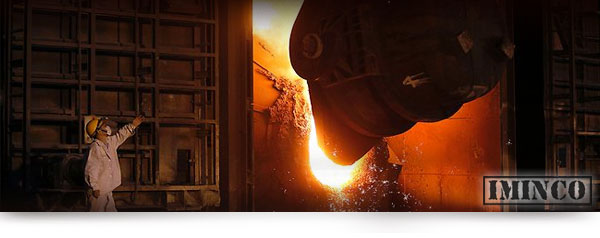 China’s record imports of iron ore in November could be sustainable in the long term. Chinese imports of iron ore surged a little over 18 per cent from this time last year, reaching 77.84 million tonnes in November.
China’s record imports of iron ore in November could be sustainable in the long term. Chinese imports of iron ore surged a little over 18 per cent from this time last year, reaching 77.84 million tonnes in November.
This was a huge milestone for the China as the previous record was 74.58 million tonnes.
In terms of imports this year, the volume of iron ore stand at 746.1 million tonnes, up 10.9 per cent over the same period in 2012. This makes iron ore one of the most imported commodities China’s.
There are indications that iron ore imports into China may ease off in the next few months coming months owing to the winter weather and a rising spot price for iron ore.
Iron ore imports are affected by seasonal changes, usually peaking between November and January, before falling off in the first few months of the year.
The spot price of iron ore in Asia hovers around the $139 a tonne
The reason imports of the steel making ingredient may not peak in December or January is that rising prices have in the past acted as a dampener on demand.
The spot price of iron ore in Asia hovers around the $139 a tonne mark this month, which was close to the highest price in almost four months. The highest price paid for a metric tonne of iron ore this year was $158.90, with a slump to $110 a tonne in May.
The gains in both prices and volume of iron ore on hand in the Chinese ports have been driven by a re-stocking of inventories, which reports show is somewhere around the 87 million tonnes. An improving outlook for steel demand has been fed by the Chinese government’s willingness to commence new projects to build the country’s infrastructure as well as kick-start construction spending. This is all part of the Chinese urbanisation program to lift the country out of their current housing and population crisis.
Chinese steel consumption currently at around 2.1 million tonnes per day
The good news for Australian mining companies like Rio Tinto, BHP Billiton and Fortescue Metals Group who are major suppliers to China, is that once iron ore stocks in China reach certain levels, it’s likely the steel mills will buy only as much as they consume. Chinese steel consumption is around 2.1 million tonnes per day, which equates to approximately 766 million tonnes a year.
So while current high prices and freight rates may slow, this may only be a temporary situation because iron ore demand is expected to continue its strong growth throughout 2014. With the expectation that Chinese iron ore imports will rise to 850 million tonnes in 2014, (a gain of 6.3 percent over 2013’s forecast of 800 million tonnes), 2014 looks to be a good year for Australian iron ore mining companies.
Iron ore outlook in 2014
There are many different views as to how the global iron ore market is set to pan out. Different opinions paint different pictures of just what the driving factors will be in 2014. It’s no a secret that the Australian mining industry has been battered by severe global financial storms of late and some sectors like coal mining have been hit hard.
Iron ore`s story has been one of resilience and gutsy determination
However, despite the tough conditions in the mining sector this year, iron ore`s story has been one of resilience and gutsy determination. But the Asian powerhouse China seemed to rebound from the predictions of doom and gloom to create a strong demand throughout most of 2013.
Australian mining giants BHP Billiton and Rio Tinto have also announced they would be progressing with the expansion of their Pilbara mining operations and they had seen no underlying change in demand for iron ore. These mining companies, who play a major role in mining operations globally, stuck to their guns throughout 2013, despite the reduction of Chinese growth from 10 percent to 7 per cent.
Pilbara mines expand, creating more mining job opportunities
A quick review of mining activity in the WA Pilbara proves that mining companies like Rio Tinto, BHP Billiton and Fortescue Metals Group, not to mention the smaller miners like Atlas Iron and BC Iron have done more than enough to back-up their confidence in the iron ore industry.
- In Western Australia, BHP Billiton created more WA jobs when it opened its Jimblebar expansion last month as well as continuing to invest in other mining projects in the Pilbara, like the new $300 million port expansion project to replace 2 Nelson Point ship loaders.
- Rio has also moved ahead, most recently approving a $400 million program to increase production even further, with a cool 360 million tonnes per annum being the target for Rio Tinto from its Pilbara mines by 2017.
- The CITIC Pacific`s Sino Iron project, which is many years behind schedule and literally billions of dollars over budget, is kicking into gear with the commencement of production and shipping of its first iron ore from Cape Preston.
- Arrium mining in South Australia also have proved to be a force to be reckoned with in the Australian iron ore business, with their board recently approving the resumption of mining at their�Iron Knob mine which is situated just 50kms from Whyalla. They also have big plans for three new pits close to the coastal town.
- Not forgetting the ‘top end’ as the Northern Territory makes a play for recognition as a serious contender for iron ore bragging rights with Western Desert Resources having stockpiled 600,000 tonnes of iron ore from its Rope River iron ore mine.
Get up to speed with WA iron ore mining
- Fortescue Metals “� Biggest Iron Ore Shipment
- Mining Jobs WA “� How To Increase Your Job Opportunities
- Iron Ore Demand Increases “� Pilbara Mining Jobs On The Way
- 500 Entry Level Mining Jobs On Offer
- Leighton Scores $2.8 billion Pilbara Mining Deal
- Fortescue Metals “� Pilbara Mining Jobs Video
- WA Mining Jobs

